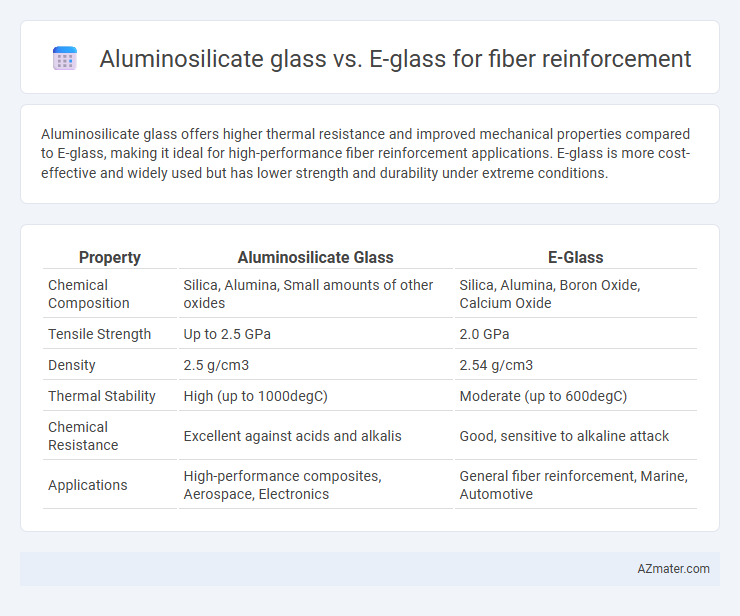Aluminosilicate glass offers higher thermal resistance and improved mechanical properties compared to E-glass, making it ideal for high-performance fiber reinforcement applications. E-glass is more cost-effective and widely used but has lower strength and durability under extreme conditions.
Table of Comparison
| Property | Aluminosilicate Glass | E-Glass |
|---|---|---|
| Chemical Composition | Silica, Alumina, Small amounts of other oxides | Silica, Alumina, Boron Oxide, Calcium Oxide |
| Tensile Strength | Up to 2.5 GPa | 2.0 GPa |
| Density | 2.5 g/cm3 | 2.54 g/cm3 |
| Thermal Stability | High (up to 1000degC) | Moderate (up to 600degC) |
| Chemical Resistance | Excellent against acids and alkalis | Good, sensitive to alkaline attack |
| Applications | High-performance composites, Aerospace, Electronics | General fiber reinforcement, Marine, Automotive |
Introduction to Fiber Reinforcement Materials
Aluminosilicate glass fibers offer superior chemical resistance and higher tensile strength compared to E-glass fibers, making them ideal for demanding fiber reinforcement applications. E-glass fibers remain the most widely used due to their cost-effectiveness, good mechanical properties, and excellent electrical insulation. Both materials serve as essential reinforcements in composite structures, but the choice depends on required durability, strength, and environmental stability.
Overview of Aluminosilicate Glass
Aluminosilicate glass, characterized by its high aluminum oxide content, offers superior thermal stability and mechanical strength compared to traditional E-glass. Its enhanced chemical resistance and lower coefficient of thermal expansion make it ideal for demanding fiber reinforcement applications in aerospace and automotive industries. This glass type provides improved durability under high-temperature and corrosive environments, contributing to longer-lasting composite materials.
Overview of E-Glass
E-glass, or electrical-grade glass, is the most common fiber reinforcement material used in composites due to its excellent balance of mechanical strength, thermal resistance, and cost-effectiveness. Composed primarily of silica, alumina, calcium oxide, boron oxide, and magnesia, E-glass fibers offer high tensile strength and good electrical insulation properties, making them ideal for applications in aerospace, automotive, and marine industries. Compared to aluminosilicate glass, E-glass provides superior manufacturability and consistent quality, although aluminosilicate glass can offer enhanced temperature resistance for specialized high-performance composites.
Chemical Composition Comparison
Aluminosilicate glass fibers are primarily composed of silica (SiO2), alumina (Al2O3), and smaller amounts of other oxides such as sodium oxide (Na2O) and potassium oxide (K2O), which enhance their thermal stability and chemical resistance. E-glass fibers, mainly consisting of silica (SiO2), calcium oxide (CaO), and aluminum oxide (Al2O3), offer excellent electrical insulation and moderate chemical durability. The higher alumina content in aluminosilicate glass improves its resistance to acid and alkali corrosion compared to the calcium-rich composition of E-glass, making aluminosilicate fibers more suitable for harsh chemical environments.
Mechanical Properties: Strength and Modulus
Aluminosilicate glass fibers exhibit higher tensile strength and improved thermal stability compared to E-glass fibers, making them suitable for high-performance composite applications. The modulus of aluminosilicate fibers generally surpasses that of E-glass, offering enhanced stiffness and resistance to deformation under load. E-glass fibers, while offering good strength and a moderate modulus, are often favored for cost-effectiveness and wide availability in standard reinforcement uses.
Thermal Stability and Heat Resistance
Aluminosilicate glass exhibits superior thermal stability and heat resistance compared to E-glass, making it ideal for high-temperature fiber reinforcement applications. Its enhanced composition allows aluminosilicate fibers to maintain mechanical strength and structural integrity at temperatures exceeding 700degC, while E-glass fibers typically degrade above 500degC. The improved thermal durability of aluminosilicate glass results from its higher alumina content, which reduces thermal expansion and increases softening point, contributing to longer-lasting performance in heat-intensive environments.
Corrosion and Chemical Resistance
Aluminosilicate glass exhibits superior corrosion and chemical resistance compared to E-glass, making it ideal for fiber reinforcement in harsh chemical environments. Its enhanced alkali resistance and stability against acidic and basic substances prevent degradation over prolonged exposure. In contrast, E-glass fibers are more susceptible to surface corrosion in alkaline conditions, which can compromise mechanical performance and durability in certain applications.
Cost and Availability Factors
Aluminosilicate glass fibers generally offer higher thermal resistance and mechanical strength compared to E-glass but come at a significantly higher cost due to more complex manufacturing processes and raw material expenses. E-glass fiber remains the most widely available and cost-effective option for fiber reinforcement, benefiting from established production scales and global supply chains. In industries where budget constraints and mass production are critical, E-glass is preferred, while aluminosilicate glass fibers are selected for specialized applications demanding superior performance despite a premium price.
Typical Applications in Industry
Aluminosilicate glass fibers are commonly used in high-temperature and corrosion-resistant applications, such as flame-resistant textiles, aerospace components, and electrical insulation. E-glass fibers dominate general-purpose composites in automotive, marine, and construction industries due to their excellent strength-to-weight ratio and cost-effectiveness. Both materials serve critical roles in fiber-reinforced polymers, with aluminosilicate preferred for extreme environments and E-glass for versatile, everyday structural uses.
Selection Guidelines: Which Glass to Choose?
Aluminosilicate glass offers superior thermal stability and higher tensile strength compared to E-glass, making it ideal for high-performance fiber reinforcement in aerospace and military applications. E-glass provides excellent cost-effectiveness, chemical resistance, and balanced mechanical properties suitable for general-purpose composite manufacturing. Selection of glass fiber reinforcement depends on application requirements: choose aluminosilicate for high-temperature or high-strength demands, while E-glass remains preferred for structural components where affordability and corrosion resistance are prioritized.

Infographic: Aluminosilicate glass vs E-glass for Fiber reinforcement
 azmater.com
azmater.com